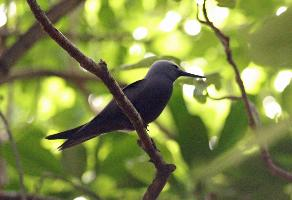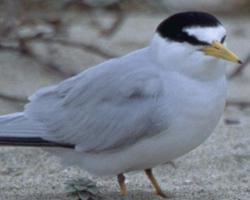
Greutăți și măsuri
| Lungime | de la 25 la 28 cm |
|---|---|
| Lungimea anvergurii aripilor | de la 46 la 60 cm |
Descrierea animalului
The Blue Noddy, scientifically known as Anous ceruleus, is a captivating species of seabird that is a member of the tern family Laridae. This relatively small bird boasts a unique and attractive appearance that sets it apart from its relatives. It is primarily found in certain regions of the Pacific Ocean, often around tropical and subtropical islands.One of the most striking features of the Blue Noddy is its plumage, which, as the name suggests, exhibits varying shades of blue-gray. This coloration is quite unusual among terns, making the Blue Noddy quite distinctive. The feathers on its back and wings are a deeper shade, while the underparts tend to be lighter, creating a subtle but beautiful contrast that can be mesmerizing when observed in their natural habitat.
The Blue Noddy has a slender and streamlined body adapted for an aerial lifestyle, with long, narrow wings that enable it to glide effortlessly over the ocean surface. Its tail is slightly forked, which aids in its maneuverability and agility in flight. The bird's overall body length can range from about 30 to 36 centimeters (12 to 14 inches), with a wingspan that typically extends around 70 centimeters (27 inches).
The head of the Blue Noddy is small and rounded, with a relatively short, sharp bill that is well-suited for catching its primary diet of small fish and squid. Around the face, the feathers are slightly paler, and the bird's eyes are dark and beady, providing it with keen vision necessary for spotting prey from above the water.
One of the most interesting behaviors of the Blue Noddy is its nesting habits. Unlike many other seabirds, Blue Noddies do not dig burrows or build elaborate nests. Instead, they often lay their single egg on bare rock ledges, in crevices, or in the branches of trees or shrubs, with minimal nesting material. This simple approach to nesting is thought to be an adaptation to their island habitats, where resources can be scarce.
Blue Noddies are known for their gentle and approachable demeanor, often allowing humans to come quite close without showing signs of distress. This has made them a favorite among birdwatchers and researchers alike. However, their trusting nature also makes them vulnerable to introduced predators on islands, which can pose a significant threat to their populations.
In terms of vocalization, Blue Noddies are typically not as noisy as some other tern species. Their calls are usually soft and include a variety of whistles and crooning sounds, particularly during the breeding season when they are communicating with their mates or signaling alarm.
The conservation status of the Blue Noddy is generally considered to be of least concern, although like many seabirds, they can be affected by changes in their environment, including pollution, overfishing, and climate change. Conservation efforts are important to ensure that these serene and beautiful birds continue to grace the skies and seas of the Pacific for generations to come.
Animale similare
Fotografii noi cu animale
Top 10 animale
- Dolphin gull (Leucophaeus scoresbii)
- Diana monkey (Cercopithecus diana)
- Moustached guenon (Cercopithecus cephus)
- Galápagos tortoise (Geochelone nigra complex)
- Japanese macaque (Macaca fuscata)
- Stone loach (Barbatula barbatula)
- Greek tortoise (Testudo graeca)
- Russian tortoise (Testudo horsfieldii)
- Common flying dragon (Draco volans)
- Galápagos penguin (Spheniscus mendiculus)


